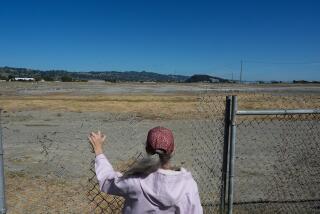Possible Asbestos Contamination Shakes a Tiny Town
LIBBY, Mont. — Bob and Carrie Dedrick’s children are so worried about the hidden threat of asbestos in and around their parents’ house that they won’t allow the Dedricks’ seven grandchildren to visit.
So the Dedricks invited the U.S. Environmental Protection Agency to take dirt from the garden, and air and dust from the house and test them for asbestos.
“Let’s find out, let’s find out,” Bob Dedrick told Montana Gov. Marc Racicot when Racicot went to the house to talk about the couple’s fears.
Libby, tucked away in Montana’s mountainous northwest corner, is a blue-collar timber and mining town at heart, and it’s taken some hard punches in the past decades as those industries tumbled. But with the Cabinet Mountains Wilderness out its back door and the Kootenai River hardly a fly-cast away, the town has worked hard to become a vacation destination and a place for retirement.
Now, with its efforts starting to bear fruit, the town has been shaken by reports that asbestos from an old vermiculite mine killed nearly 200 people, sickened hundreds of others and may pose a continuing health threat. Town boosters fear they are being knocked to their knees once again.
“There’s a lot of mixed emotions right now,” said Linda Beaulieu, executive director of the Libby Area Chamber of Commerce. “There is much compassion for these families that are ill, but a lot of people feel the facts aren’t on the table. Let’s not condemn our entire town that has worked so hard to get a place on the map.”
Business leaders complain there is a perception that the streets are coated with asbestos from the W.R. Grace and Co. mine, which closed about 10 years ago, and that sickness is everywhere in the town of 2,700 people.
Newspapers in Montana and Washington state reported the asbestos issue in November, quoting medical authorities, survivors of asbestosis and people now suffering from the disease.
The reports prompted a series of environmental tests that will continue at least into the spring. State officials say that until complete test results are in, they won’t know the extent of the health risk, if any.
Racicot, 51, who lived in Libby for his first 18 years, promised that the state and federal governments will answer the health concerns of Libby residents, determine the extent of asbestos contamination and do something about it. He also plans to get a chest X-ray.
“The most important thing here is determining facts,” he said. “If there is a public health problem or a problem with an individual family or house, they have to get it exposed.”
Racicot also said he wants to know whether state health and environmental officials, as some critics have alleged, knew of the danger in Libby and turned a blind eye.
Dr. Michael Spence, the state’s chief medical officer, estimated that 300 people in the Libby area have been diagnosed with asbestosis, but he disputed news reports that put the number of asbestos-related deaths at almost 200. He said the number is fewer than 100 statewide.
For Irene Sirey, statistics are less important than the safety of her grandchildren. She recently bought a house and had started renovating it when the asbestos concerns arose. Behind a door in a closet was a blanket of insulation, just like the mineral suspected of being laced with asbestos. The clumpy insulation was seeping from a wall socket.
“I’m very concerned for my grandkids; I have them in the summer,” said Sirey, who plans to wait for results of EPA tests on samples taken from her home before continuing with remodeling.
Libby is steeling itself against an image problem that could dampen business recruitment and real estate prices in a town where $75,000 to $90,000 still buys a three-bedroom house.
Irene Loveless of Loveless Realty said three out-of-state clients who anticipated moving here changed their minds immediately after the news coverage.
“What can we tell them, except that until the tests are complete, we don’t know if there’s any danger?” said Loveless, a 40-year resident.
Off the beaten path, yet still positioned to catch some of the traffic heading to and from Glacier National Park, Libby is prominent on the maps of fishers who come from around the country and abroad, drawn by the Kootenai River’s bull trout, westslope cutthroat trout and native rainbows.
If Libby’s image takes a hit, it will be short-term, said Gayla Benefield, a leading supporter of the asbestos investigation. Her father was a former Grace mine worker who died in 1974 of asbestos exposure at 62. Benefield said her mother, also deceased, suffered secondary exposure from the asbestos dust that her husband wore home from the mine.
“You’ve got to weigh the possibility that asbestos contamination is an ongoing situation, and weigh the cost of lives compared to tourist dollars,” Benefield said. “If there is a problem, let’s find it and solve it.”
More to Read
Sign up for Essential California
The most important California stories and recommendations in your inbox every morning.
You may occasionally receive promotional content from the Los Angeles Times.










